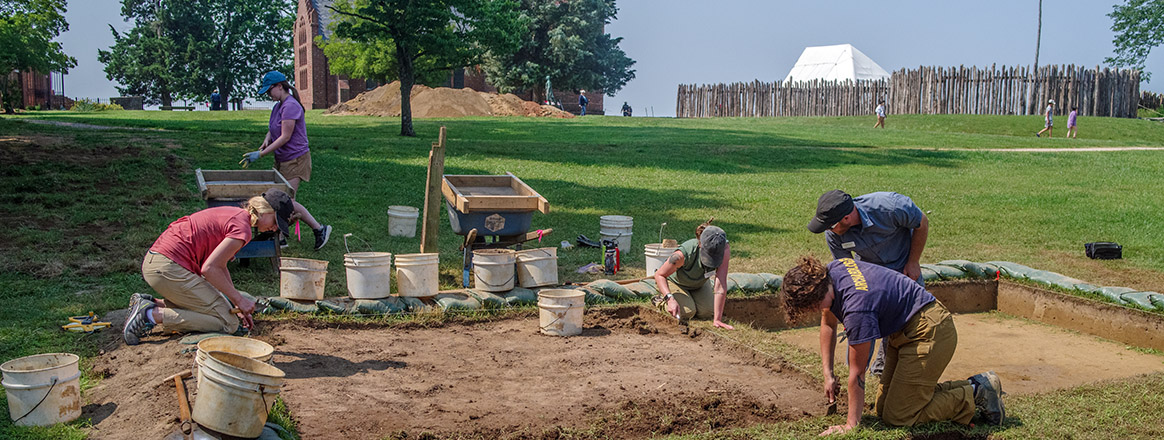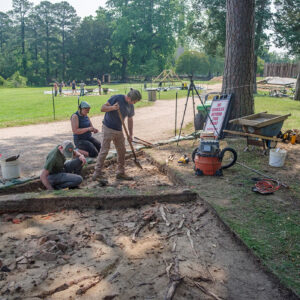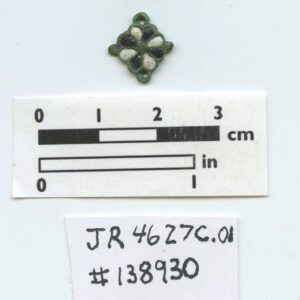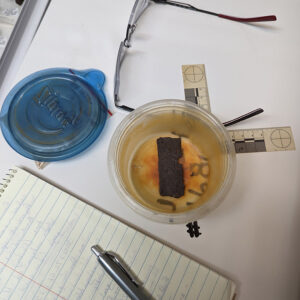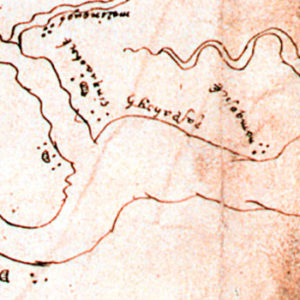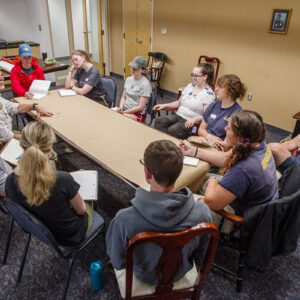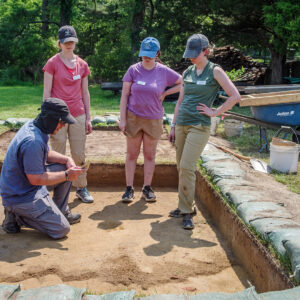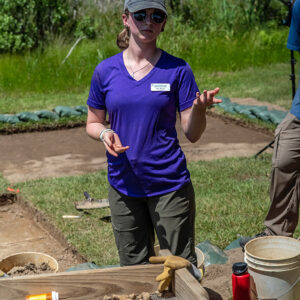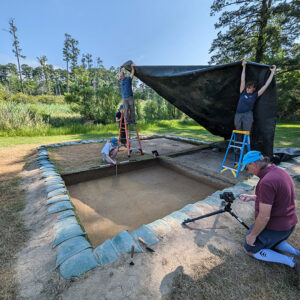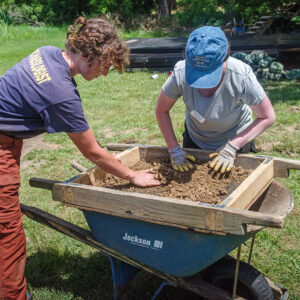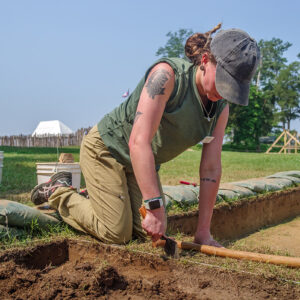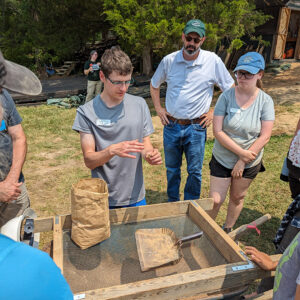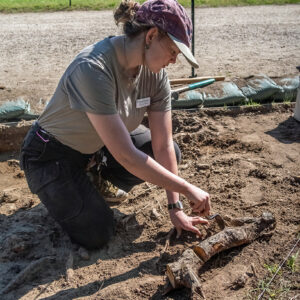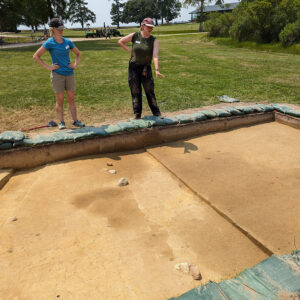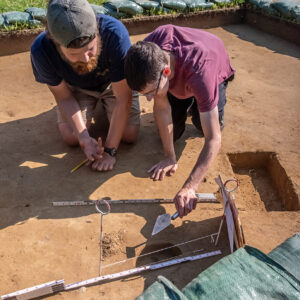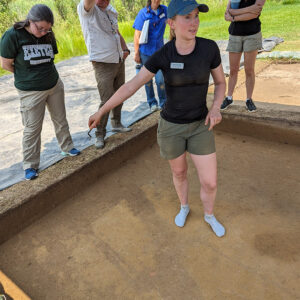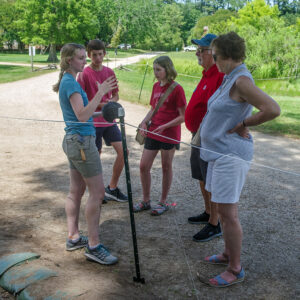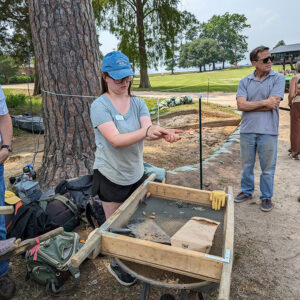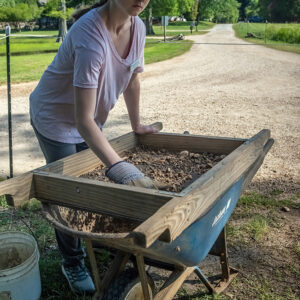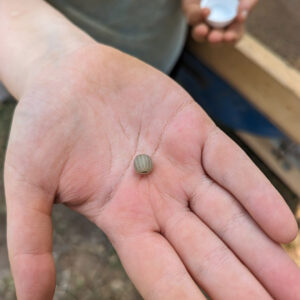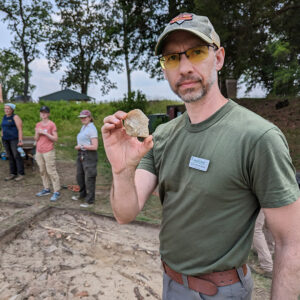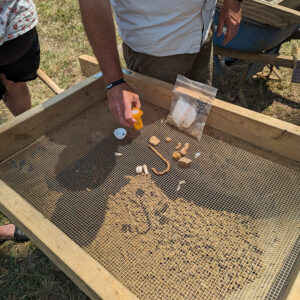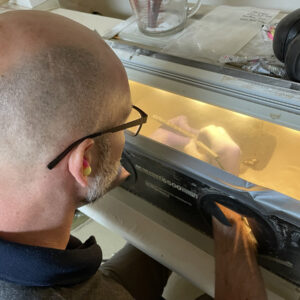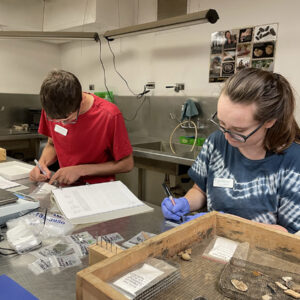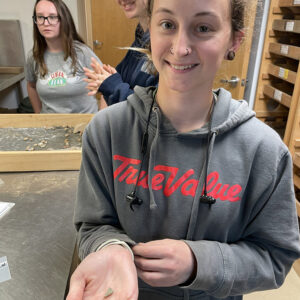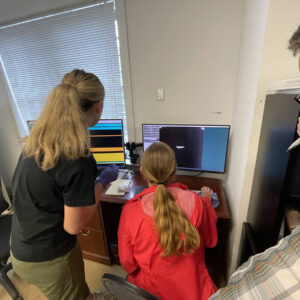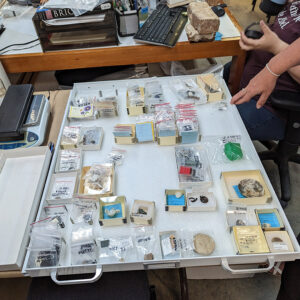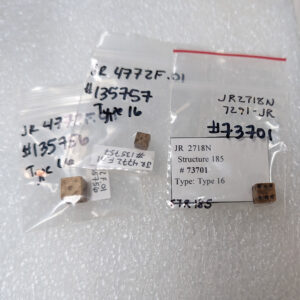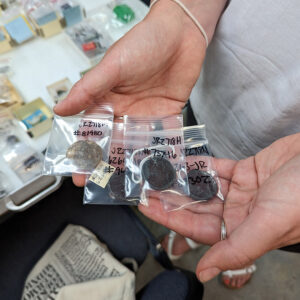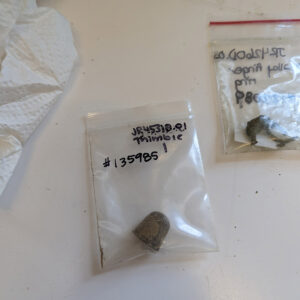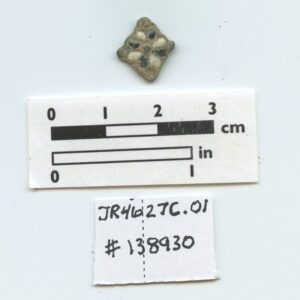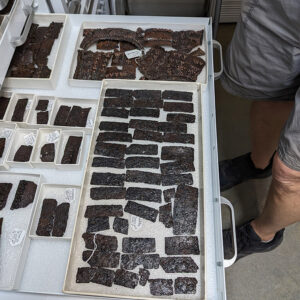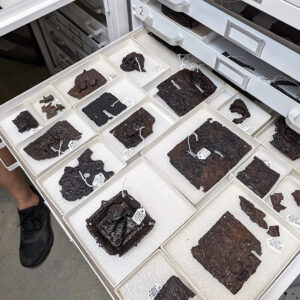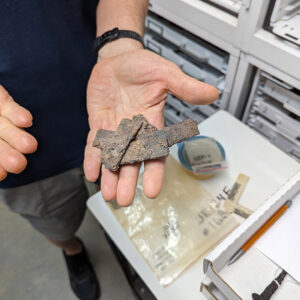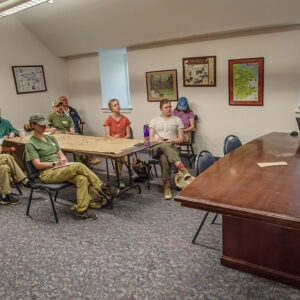The 2023 Field School is in full swing and the students and Jamestown Rediscovery archaeologists are digging in four key areas north of James Fort. Close to the swamp and the footbridge that crosses it, excavations are underway at a clay borrow pit — where earth was mined for making bricks — many of which likely still exist as part of the 1680s Church Tower. Several yards to the west a second dig area is focused on the northern extent of the “flag” feature seen on the Zuñiga Map of 1608. A portion of the flag feature — proven archaeologically to be an early-17th-century ditch — was found here as was a spur of that ditch at its northern-most extremity, also depicted on the map. Following the flag to the west, a third team is slogging through an area filled with roots from a nearby pine tree. Using the Zuñiga map and ground-penetrating radar (GPR) as their guide, this group is working in an area where the Zuñiga map appears to depict a structure of some kind, divided into four compartments, in the flag-shaped enclosure’s northwest corner. The roots and a pile of discarded bricks found here made the GPR data hard to decipher, so these excavations — also complicated by their intersection with Confederate Fort Pocahontas’s moat — will hopefully give form to the ditch and the interior feature on the map. The Field School students are also spending time in the lab, learning how to process, identify, and conserve artifacts once they’re brought in from the field. Curatorial intern Kathryn Keiserman is processing Jamestown’s collection of gaming-related and music-related artifacts for the reference collection. Collections Assistant Lauren Stephens is continuing her work on bricks, slate, and other architectural artifacts in the collection. In the lab, Senior Archaeological Conservator Dan Gamble is working on conserving artifacts being considered for inclusion in the reference collection. Among the artifacts he is conserving this month are a thimble, a Groningen token, and a decorative copper alloy object, likely a jewelry link. At the x-ray machine, Archaeological Conservator Don Warmke has scanned hundreds of artifacts over the last month including brigandine armor plates.
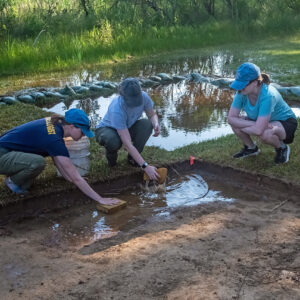
Lead by Senior Staff Archaeologist Sean Romo, the eastern-most dig site is focused on a clay borrow pit used in the second half of the 17th century to source clay for a nearby brick kiln. The pit ceased to be used near the end of the 17th century and it then served as a trash pit, meaning there could potentially be a significant number of artifacts in the fill. The pit was originally found by J.C. Harrington and his team in an exploratory trench excavated in 1941. The current dig’s scope is much larger than the area explored by Harrington’s team. The goals of this dig are twofold. First is to gain some understanding of what life was like for the residents of Jamestown near the end of its life as Virginia’s capital. The second is to understand what effect proximity to the swamp is having on the archaeological resources here. The northeast square opened in this area is often too wet to excavate yet Harrington was able to dig dozens of yards to the north in the 1940s in the center of what is now a swamp. A continuous wet/dry cycle is harmful to many different types of artifacts as well as human remains. Excavations here may give some insight into the changes occurring to archaeological resources on these front lines of the swamp’s expansion. The western-most region of the borrow pit has been found, its dark soil starkly contrasting with the surrounding space. Parallel stains in the soil could possibly be wheel ruts from a cart transporting clay out of the pit. As the team digs deeper the stains remain, unlike newer features like plow scars that fade away with depth. Further excavations may give the team more clues that support (or dismiss) the wheel rut theory. Two postholes have been found in these squares, but it is not clear yet what their purpose was. Excavations here have yielded dozens of artifacts including sherds of Delftware, colonoware, and Westerwald stoneware as well as bottle glass, pipe stems, lead shot and flint.
A short walk to the west, Senior Staff Archaeologist Mary Anna Hartley heads up the second excavation area, situated where GPR suggests the northern-most extent of the “flag” feature should be. Shovels and trowels have confirmed that this is indeed the case . . . the ditch turns to the southwest in this area. What’s more, a spur of the ditch extends to the north, just as the Zuñiga map suggests it would. The full extent of this spur has not yet been found. A circular pit approximately three feet in diameter was found here as was an additional section of a narrow east/west ditch that archaeologists are currently interpreting as a trench for a mid-17th-century palisade wall. This newly exposed portion of the possible palisade trench is similar to the section found this spring, in that it contains numerous bricks and cobblestones — including a Bermuda limestone cobble. The portion of the ditch in this area contains bricks, rocks, and Bermuda limestone just like it did to the east. A posthole, thought to belong to a fence, was found here that lines up with others found in the excavations to the east that are spaced at regular 9-foot intervals. These postholes appear to run parallel to the east/west palisade trench. A 1906 water line runs through the southern-most square in this area as do several plow scars. Lead shot, flint, pottery sherds including Martincamp and Delftware, the neck of a wine bottle, two Nueva Cadiz beads, and the base of a crucible from the Hesse region of Germany have been found in these excavations.
To the south and west, following the line of the “flag” feature, Director of Archaeology David Givens is leading the team’s investigation of the third site that will hopefully give evidence of the interior feature in the top-left corner of the “flag” as shown on the Zuñiga map. As soon as a few inches of soil was excavated, the students and archaeologists discovered why the GPR data was so hard to decipher. There is a conglomerate of pine tree roots, bricks, and even part of a displaced tombstone here that is making excavations painfully slow. The growth of the roots has pushed the soil and bricks higher up towards the surface. The bricks are notably devoid of mortar so these may not have been used in a substantial structure, if at all. The “flag” ditch again intersects Fort Pocahontas‘ moat here, as it did several yards to the east at its origin at James Fort’s north bulwark. The team is excavating down into the moat in order to create a profile that might expose the “flag” ditch. A promising soil color change is showing up as the moat excavation progresses. A very early (and very large) fishhook was found during these excavations. Hopefully the soil color change and early artifact mean the team is on the right track. In addition to the fishhook, flint flakes, sherds of Delft and Westerwald pottery, and a gooseberry bead were found here this month.
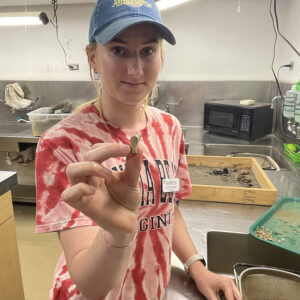
The Field School students are also learning the process of identifying and conserving the artifacts they find in the field. The collections team instructed the students on using the attributes of an artifact such as shape, size, material, and decoration, as well as archaeological context to identify it. The students have been washing artifacts and picking through debris from the fort’s first well to find tiny artifacts (crab claws, gar scales, and mussel beads are common finds). They are also using the knowledge gained from the lectures to sort and categorize artifacts after they’ve been washed. With guidance from the conservation team, the students are learning how to mend ceramics, using broken flower pots found in a modern context near the Church Tower. These are thought to be related to Ray Mallory’s fundraising efforts for the APVA (Association for the Preservation of Virginia Antiquities, now Preservation Virginia) in the 1930s when he sold clippings of ivy that were growing on the Tower. Mending ceramics not only makes vessels more complete but gives insight into their number — as opposed to the indeterminate value posed by hundreds of sherds — an important tool for the archaeological analyst.
Curatorial Assistant Lauren Stephens’ work on architectural elements in the collection has continued in June. Like many efforts by collections and conservation staff over the past several months, hers revolve around the reference collection, an effort to have an example of each type of artifact readily on hand for research by both staff and outside researchers. Those researchers interested in a certain type of artifact can then access any additional examples in the archive. Lauren has identified several different types of brick, cataloging them as she goes, including those with animal prints and human fingerprints on them, as well as roof slate and other materials for inclusion in the reference collection.
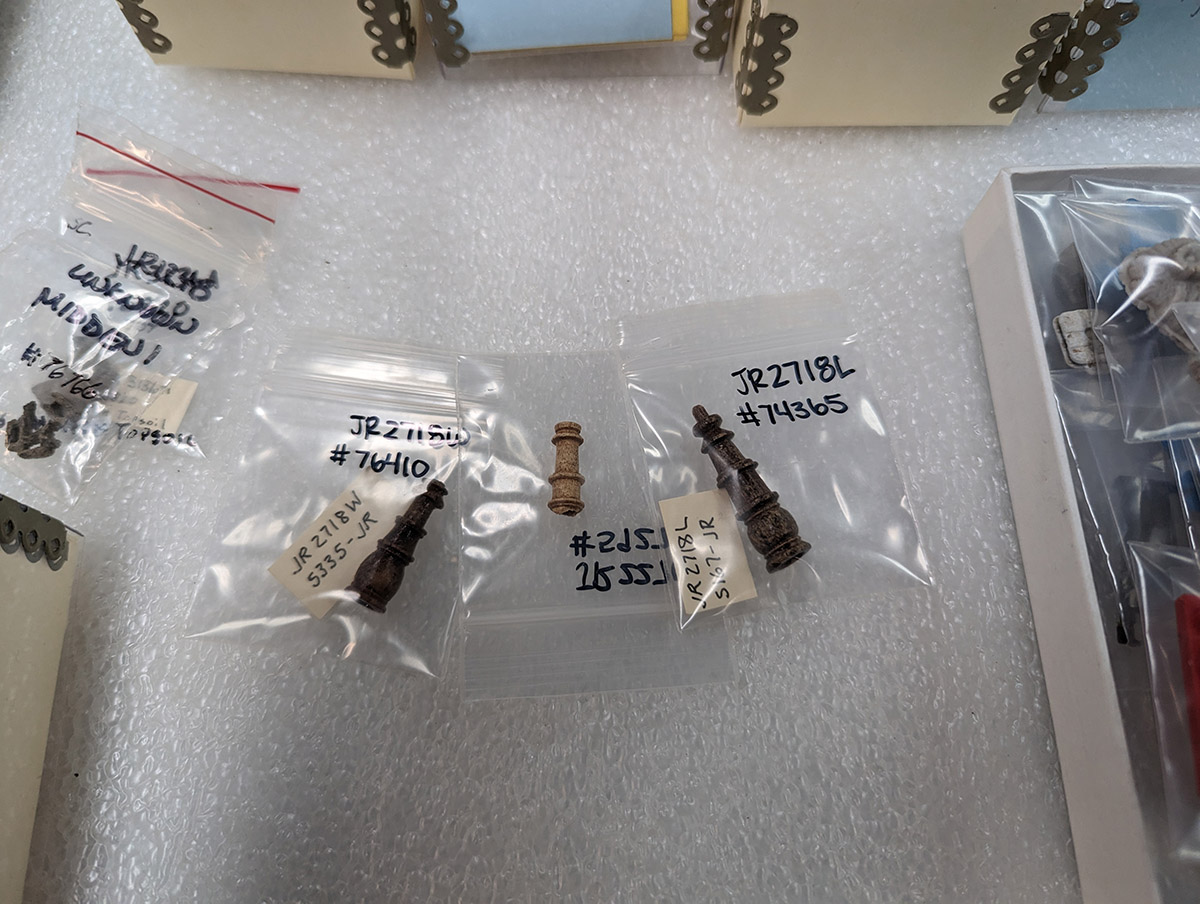
Curatorial intern Kathryn Keiserman has joined the team for the summer and is working on toys and gaming-related artifacts for the reference collection. The collection includes artifacts ranging from a toy house and chess pieces from the 17th century to modern marbles likely dropped by visitors. Kathryn is in the Vault, organizing the artifacts and finding examples of each type for the reference collection. Among the artifacts the collections team is less certain about are a series of nondescript lead circular objects. The current theory is that they were used for gaming, perhaps backgammon. Chess and backgammon sometimes shared a board, with each played on opposite sides. Since there are a number of chess pieces in the collection, there might have also been a chess/backgammon board. Kathryn is also looking through the collection of music-related artifacts, likewise to include examples of these in the reference collection. Kathryn is examining two copper alloy horn mouthpieces found by Jamestown Rediscovery archaeologists, one from an early fort-period context, and one from decades later. Kathryn was awarded one of the Woody Internships in Museum Studies, provided through the Charles Center at William & Mary.
Next door in the lab, Senior Archaeological Curator Dan Gamble is conserving unidentified objects to determine whether they warrant inclusion in the reference collection. These artifacts — often covered in dirt and centuries of corrosion — cannot be identified prior to conservation. Sometimes an x-ray is sufficient to identify an object as is the case with some coins, with details such as the date and mint mark visible in the image. This can be enough to determine whether an example already exists in the reference collection and Dan’s efforts could be spent on another artifact. But for those objects for which the x-ray is not enough to identify it, Dan will remove the corrosion using methods determined by the artifact’s condition and material. Among the artifacts Dan is working on this month are a thimble, a Groningen token, a finger ring, and a copper alloy decorative object, likely a jewelry link. The decorative object is diamond shaped with eight enameled black and white teardrop-shaped decorations and two holes on opposite sides. Prior to conservation these holes weren’t visible and corrosion and caked-on soil made analysis of the artifact difficult. And while the team still isn’t sure what it was used for, the holes and details give them clues that will help their research going forward.
Archaeological Conservator Don Warmke continues his work at the x-ray machine, having completed over 650 scans over the past few months, mostly on iron artifacts. One such artifact is a piece of brigandine armor, the metal for which originally came from an iron lock. This was a not-uncommon occurrence at Jamestown, reusing iron for different purposes, perhaps when the metal was scarce or when it was cheaper to refashion an existing object rather than start from scratch. This piece of brigandine has a hole at one edge, part of a keyhole from the lock. The Jamestown collection has dozens of pieces of brigandine armor and many locks as well, most of them stored in the Vault’s dry room or the Archaearium museum.
related images
- Excerpt from the Zuñiga Map showing James Fort and the “flag” feature extending from its north bulwark
- Director of Archaeology David Givens gives an introduction to surveying, mapping, and recording to the Field School students and supervisors.
- Senior Curator Merry Outlaw gives a tour of the Vault to the Field School students.
- Senior Staff Archaeologist Sean Romo teaches proper troweling techniques to some of the Field School students.
- Field School student Ren Willis shares the findings at the clay borrow pit excavations with staff and visitors.
- Senior Staff Archaeologist Sean Romo and Archaeological Field Technician Brenna Fennessey shade the clay borrow pit while Senior Staff Archaeologist Dr. Chuck Durfor takes record shots.
- Archaeological Field Technician Brenna Fennessey and Field School student Sarah Hespe screening at the clay borrow pit excavations.
- Field School student Ren Willis digging at the clay borrow pit.
- Field School student Drew Parker talks about some of the artifacts found at the clay borrow pit excavations.
- Field School student Eleanor Robb works around roots at the west “flag” excavation area.
- Field School student Eleanor Robb explains the progress made by her team at the north field excavations.
- Archaeological Field Technician Josh Barber teaches Field School student Drew Parker how to bisect a posthole.
- Field School students and archaeologists at the north field excavations
- Archaeologists and Field School students digging at the north field excavation area. A glimpse of the 1906 water line trench is at bottom left.
- Field School student Janne Wagner explains the north field excavation units to guests and staff during the weekly walkabout.
- Field School student Katherine Griffith shares artifacts found at the north field excavations.
- Field School student Katherine Griffith explains the dig at the west “flag” excavations to some visitors.
- Field School Student Sarah Hespe shares some of the artifacts found at the west “flag” excavations.
- Field School student Katherine Griffith screening for artifacts.
- A gooseberry bead found at the west “flag” excavation units.
- Field School Student Kurt Fredrickson holds a lithic flake found in the west “flag” excavations.
- A screen of artifacts found at the west “flag” excavation units. Note the early 17th-century fishhook.
- The root-filled and brick-filled west “flag” excavations.
- Field School student Kurt Fredrickson using the air abrasion machine to remove corrosion from a spike from Fort Pocahontas’ gun platform.
- Field School students Drew Parker and Sarah Hespe sorting artifacts in the lab.
- Field School student Ren Willis holds a sherd of a celadon bottle she found during sorting.
- Field School students Katherine Griffith and Janne Wagner learn to use an X-ray machine with the guidance of Archaeological Conservator Dr. Chris Wilkins.
- Curator Leah Stricker guides the Field School students through mending flower pots found near the Church Tower.
- A tray of toys and gaming-related objects in the Jamestown collection
- The toy house/windmill. This is one of two in the Jamestown collection.
- Three of the dice in the Jamestown collection
- The lead nondescript discs thought possibly to be gaming pieces
- A copper alloy thimble in the queue for conservation.
- Copper alloy decorative object (likely a jewelry link) before conservation
- A tray of brigandine armor pieces in the dry room
- Lock parts in the dry room. These were sometimes refashioned as brigandine armor pieces.
- Several brigandine pieces concreted together
- Senior Staff Archaeologist Mary Anna Hartley gives a lecture on the archaeology of Jamestown’s churches to the Field School students.


